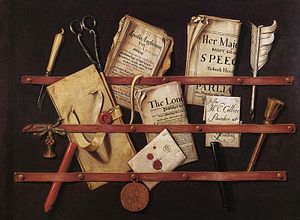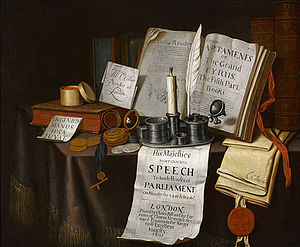


Evert Collier (26 January 1642 – few days before 8 September 1708) was a Dutch Golden Age still-life painter known for vanitas and trompe-l'œil paintings. His first name is sometimes spelled "Edward" or "Edwaert" or "Eduwaert" or "Edwart," and his last name is sometimes spelled "Colyer" or "Kollier".
Life
Collier was baptized Evert Calier in Breda, North Brabant. [1] He was trained in Haarlem, where his earliest paintings show the influence of Vincent Laurensz van der Vinne, who became a member of the Haarlem Guild of St. Luke in 1649, and whose son Laurens van der Vinne listed "Evert Colier" in 1702 as one of the Haarlem guild members who had known his father. [2] Van der Vinne was probably his teacher when Collier registered with the Haarlem guild in 1664. [3] They both later influenced the Haarlem still-life painter Barend van Eisen. [1]
By 1667, Collier had moved to Leiden, where he became a member of the Leiden Guild of St. Luke in 1673. He moved to Amsterdam by 1686 and to London in 1693. He returned to Leiden in the years 1702–1706, based on signed and dated works there, but was back in London at the end of his life where he was buried September 8, 1708 at St. James's, Piccadilly. [4]
The Denver Art Museum, the Honolulu Museum of Art, the Indianapolis Museum of Art, the National Portrait Gallery (United Kingdom), the Rijksmuseum (Amsterdam) and the Tate (London) are among the public collections having paintings by Evert Collier.
The US historian, Dror Wahrman, has written a book on Collier's trompe-l'œil works, Mr. Collier's Letter Racks (OUP, 2014). The book brings together a wide range of the painter's still lifes from the late 17th and early 18th centuries, mostly from the time when Collier was living in London. Their themes were almost exclusively arrangements of journals, engravings, letters, medals, combs, sealing wax sticks and other ephemera, signifying an updating of the older 'memento mori' still life model.
Works
His works tend to be an arrangement of pieces of paper painted to "pop out" of the surface in a trompe-l'œil fashion. Like Van der Vinne before him, he often included prints, but these tended to be popular prints of the day.
An oil on canvas painting (Vanitas Still Life with Globe, Skull and Violin) previously attributed to Collier was later attributed to Pieter Legouch. [5]
-
A trompe-l'œil still life of a letter rack, 54 x 67.3 cm, includes a print after Staverenus
-
Smell, c. 1650, by Petrus Staverenus
- A Trompe-l'œil of Newspapers, Letters and Writing Implements on a Wooden Board (1699), 58.8 × 46.2 cm
- Edward Collier (1683), Oil on Canvas, 44.4 × 52.8 cm
- Still Life (1699), Oil on Canvas, 76.2 × 63.5 cm
- Still Life: The Smell (1695), Oil on Canvas, 24 5/8 × 20 1/2 in
- Still Life: Parliament (1695), Oil on Canvas, 24 1/2 x 29 3/4 in, M.S. Rau Antiques, New Orleans
- Still Life with a volume of Wither's Emblemes (1696), Oil on Canvas, 83.8 × 107.9 cm
- A Vanitas
- Vanitas (1662), Oil on Wood, 94 × 112.1 cm
- Vanitas Still Life (1684), Oil on Canvas, 99 × 123 cm
- Self Portrait with Vanitas Still Life (1684), Oil on Canvas, Honolulu Museum of Art
Notes
- ^ a b Edwaert Collier in the RKD
- ^ De archiefbescheiden van het St. Lukasgilde te Haarlem 1497-1798, Hessel Miedema, 1980, ISBN 90-6469-584-9
- ^ Though Collier is listed in the Haarlem guild register as a member on a page headed "1646", the last two digits must have been switched and he probably became a member in 1664 (a year suspiciously lacking member registrations), like other members listed with him and mistakenly registered on that page, such as Evert Oudendijck and Egbert van Heemskerck.
- ^ According to Paul Taylor, Londen, July 1999
- ^ "toegeschreven aan Pieter Legouch". RKD. Retrieved October 29, 2021.
Attribution:
 This article incorporates text from a publication now in the
public domain:
Bryan, Michael (1886).
"Coleyer, Evert". In Graves, Robert Edmund (ed.). Bryan's Dictionary of Painters and Engravers (A–K). Vol. I (3rd ed.). London: George Bell & Sons.
This article incorporates text from a publication now in the
public domain:
Bryan, Michael (1886).
"Coleyer, Evert". In Graves, Robert Edmund (ed.). Bryan's Dictionary of Painters and Engravers (A–K). Vol. I (3rd ed.). London: George Bell & Sons.
References
- Netherlands Institute for Art History (Dutch only)
- Allgemeines Lexikon der bildenden Künstler von der Antike bis zur Gegenwart / unter Mitwirkung von 300 Fachgelehrten des In- und Auslandes; hrsg. von Ulrich Thieme und Felix Becker (1907–1950)
- Adriaan van der Willigen en Fred G. Meijer, A Dictionary of Dutch and Flemish Still-life Painters Working in Oils, 1525–1725, Leiden 2003
Further reading
- Tuominen, Minna: The Still Lifes of Edwaert Collier (1642–1708). Ph.D. thesis. University of Helsinki, 2014. ISBN 978-952-10-9980-9 ( On-line version.)
- Wahrman, Dror: Mr. Collier's Letter Racks, Oxford University Press, 2014. ISBN 978-0-19-973886-1

